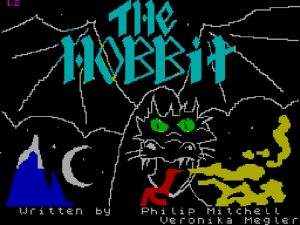Philip Mitchell
 About Philip Mitchell:
About Philip Mitchell:Philip Mitchell joined Beam Software in 1982 encouraged by his friend Veronika Megler who had answered Alfred Milgrom’s advertisement for programming students posted at the University of Melbourne. Megler and Mitchell were two of Beams earliest employees and when they were not at university pursuing their studies Mitchell and Megler worked closely together on the design of “The Hobbit”.
Mitchell is most celebrated for the complex parser he created for that game. He named the parser INGLISH it was far more sophisticated than the two word commands that supported by the popular Scott Adams Adventure series. Mitchell’s parser allowed for complex commands to be typed in. Featuring a vocabulary of 800 words, it supported combinations of nouns verbs and adverbs. You could string commands together with the use of “AND”. You could pick up objects and interact with them in the world and talk with other characters using a “SAY” command.
At university Mitchell had worked with big main frame computers and always preferred to program in machine code. He was renowned at Beam for his ability to take apart hardware and put it back together with ease and was responsible for the memory enhanced TRS80s that Beam used to program “The Hobbit”. When Megler left Beam on graduation to look for a ‘real job’ Mitchell was tasked with crunching “The Hobbit” code, plus the new graphics that Milgrom had decided to squeeze in at the last moment, into the Spectrum’s 64K. A task he performed with great finesse meaning “The Hobbit” was able to offer one of the richest experiences available on the Spectrum at the time.
Mitchell and Megler worked on one other game together “Penetrator” (1983), a “Scramble” clone that offered fast and challenging gameplay. “Penetrator” was well received. As part of the game they packaged up the editor they had written when they became tired of calculating bitmaps by hand.
The popularity of “The Hobbit” meant that Milgrom had Mitchell porting “The Hobbit” to as many microcomputers as were viable and it was not till 1984 that Melbourne House released Mitchell’s next game “Sherlock” (1984), a text adventure based on the exploits of Sherlock Holmes which also used the INGLISH parser. After “Sherlock“ Mitchell worked on three more Tolkien based text adventures for Beam, “The Fellowship of the Ring” (1986), “The Shadows of Mordor” (1987) and “The Crack of Doom” (1989).
“Melbourne Draw” (1983) was based on a tool that Mitchell wrote in consultation with Beam’s first artist Russel Comte, it was a more user friendly version for commercial release. One of the few of Beam’s many proprietary tools to receive a broader release.
Milgrom remembers Mitchell as a meticulous and ingenious programmer. Gregg Barnett, who did the C64 port of “The Hobbit”, speaks highly of Mitchell’s elegant code and superior documentation of “The Hobbit” allowing for fast and literal ports.
Mitchell stayed with the studio till 2000 (?) at which time it was known as Melbourne House Studios.
References: “Elementary Dr Watson” (An Interview with Philip Mitchell) Popular Computing Weekly, October 1983, p.13, retrieved from World Of Spectrum,; World of Spectrum; “The Hobbit” & “The Hobbit Redux”, The Digital Antiquarian, November 2012 http://www.filfre.net/2012/11/the-hobbit/; “Its a Mugs Game” (interview with Russel Comte) Sinclair User, October 1984, p.102 Retrieved from World of Spectrum; Alfred Milgrom Interview with ACMI, 2006; Gregg Barnett Interview with Play it Again, 29 December 2012
Images:
Other games developed:
The Hobbit (1982), Penetrator (1982), Melbourne Draw (1983), Sherlock (1984), Mugsy (1984), The Fellowship of the Ring (1986), The Shadow of Mordor (1987), The Crack of Doom (1989).

